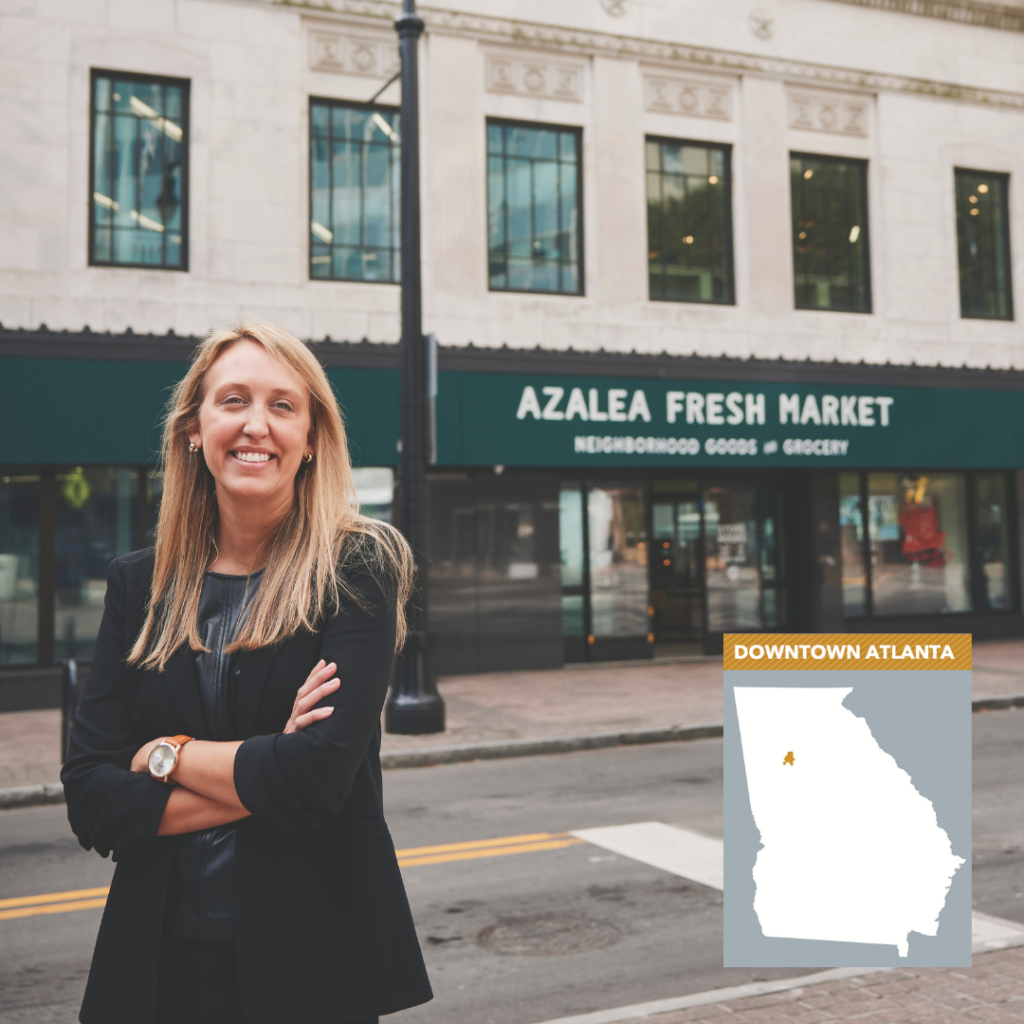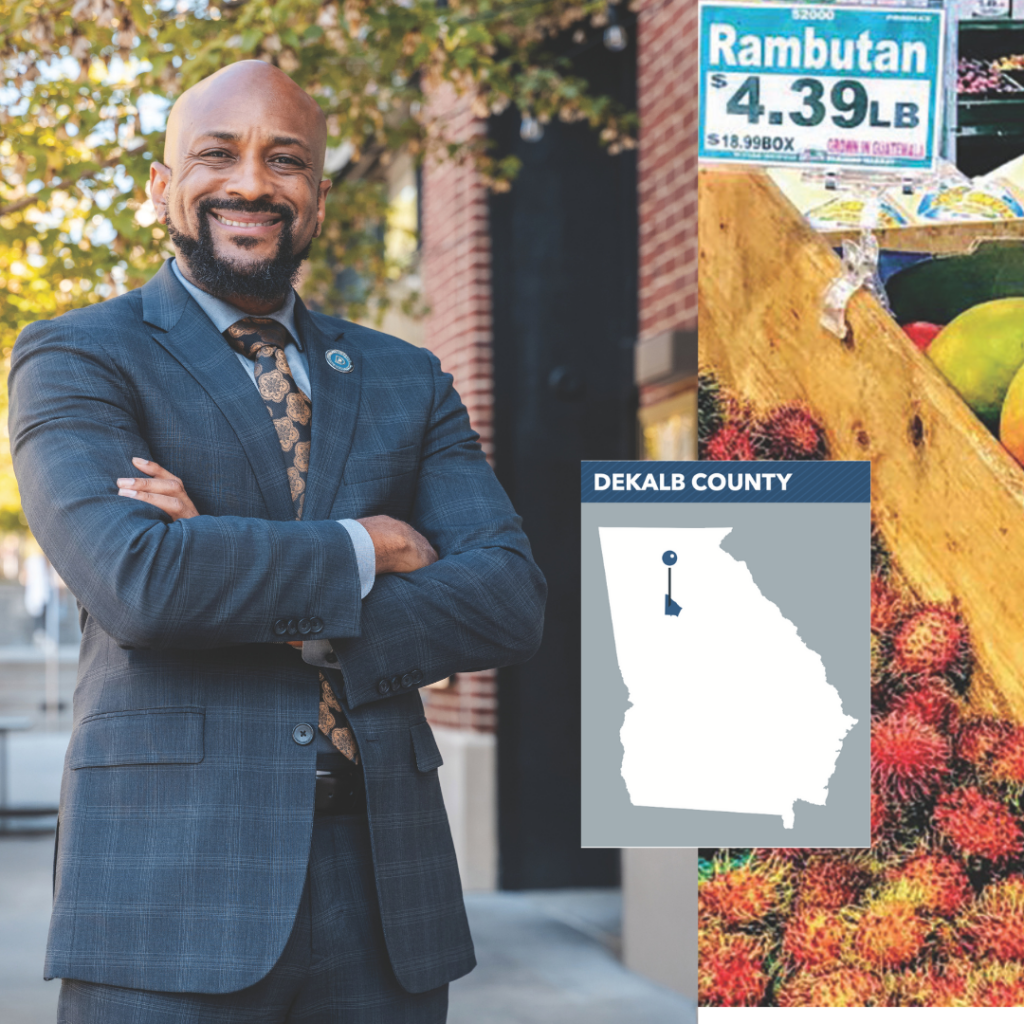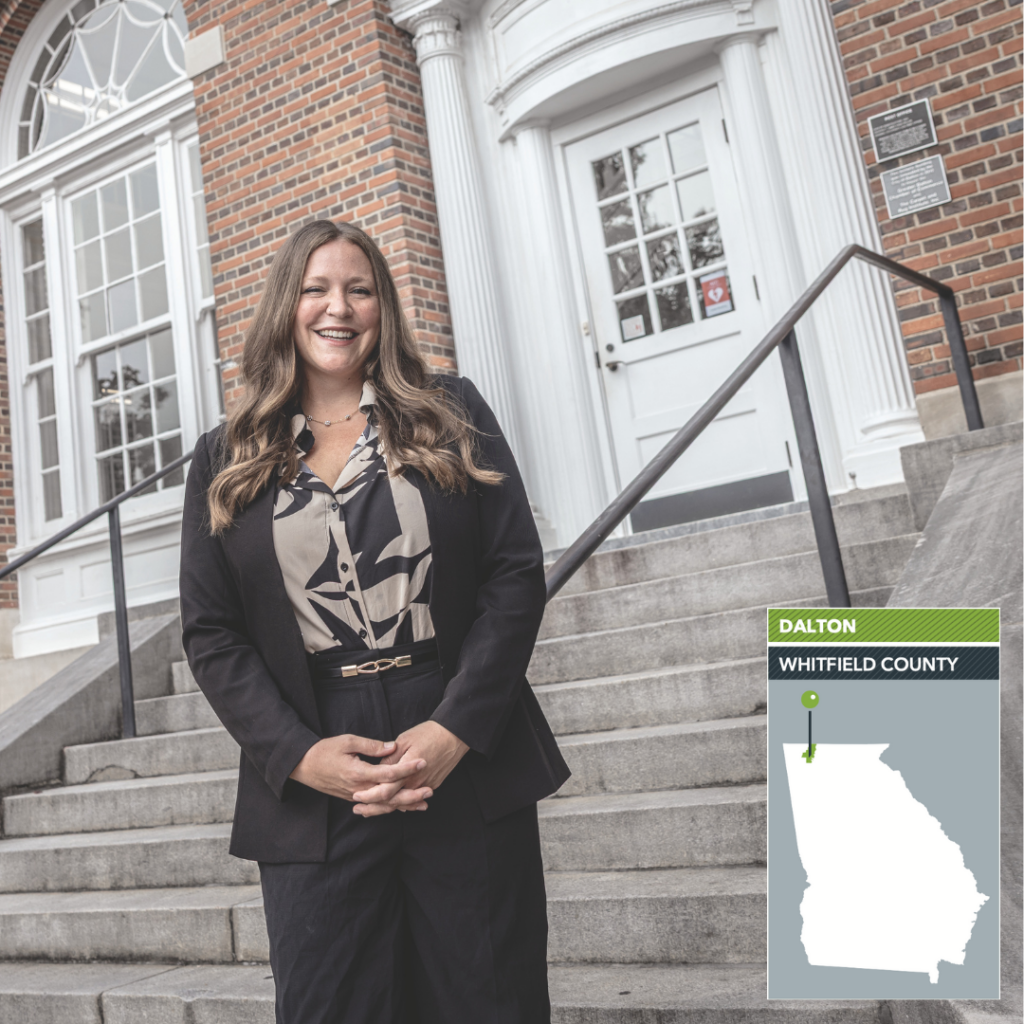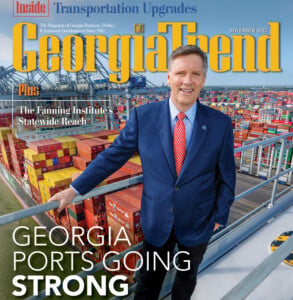Savannah: Rising to the Occasion
Workforce, Housing, Tourism
Savannah is on a mission to RISE up. RISE stands for Regional Industry Support Enterprise, a Savannah-based, multicounty organization that was formed to help coastal Georgia and its environs meet the labor demands of a growing industrial sector.

Developing Relationships: Anna Chafin, president and CEO of RISE (Regional Industry Support Enterprise), at a welding class at Woodville-Tompkins High School. Photo credit: Frank Fortune
The clock started ticking on that demand three years ago, when Hyundai announced it was building a new electric vehicle assembly plant in coastal Georgia’s Bryan County – the largest economic project in state history. The plant, which started turning out EVs in October, ahead of schedule, will account for at least 8,500 jobs when it is fully ramped up in five or six years, and ultimately around 14,500 jobs when the various supplier plants around the region are taken into account. It’s already drawn 18 suppliers that account for 6,976 jobs in the surrounding counties.
“We’re trying to go out to other communities, mainly up north, and get people to move here that want a better quality of life,” says Hugh “Trip” Tollison, president and CEO of the Savannah Economic Development Authority.
Tollison insists the labor situation is not at a panic point, and says the goal is to prevent that.
“The real demand on the workforce hasn’t hit yet, but I will say, across the board, people are always looking for new talent,” he says. “We do have to take into account that all of our major manufacturers are hiring right now. For example, Gulfstream would hire 1,200 people right now if they could get them.”
Business and private jet manufacturer Gulfstream Aerospace is headquartered in Chatham County and remains the county’s largest manufacturing employer. At the end of 2024, the company announced it had produced its 1,000th aircraft wing since starting production in the manufacturing plant in 2012.

Successful Project: The Hyundai Motor Group Metaplant America in Bryan County started producing EVs last fall ahead of schedule. Photo credit: Hyundai Motor Group
The Savannah Harbor-Interstate 16 Corridor Joint Development Authority – a four-county consortium – commissioned a 2023 workforce study to document present and future needs for workers. That study found that the local labor supply was already tight, and RISE grew out of that study. Over the course of 2024, RISE gathered eight dues-paying members from among the counties of Bulloch, Bryan, Candler, Chatham, Effingham, Evans, Liberty and Screven. RISE is now officially in business, with its own board, a staff of four and offices in SEDA’s building.
“Based on our workforce study, we know that [in] 2026, 2027, 2028, we’re going to have to really work hard on either getting people to move here or getting kids better skilled out of high school,” Tollison says.
That work, he says, began with RISE tackling several areas of concern: childcare, enabling parents to enter the workforce; transportation, so people can get to work; education at both the K-12 and post-high school level; housing; and marketing, to attract people relocating, largely with a social media campaign focused on quality of life on the coast.

Seeking New Talent: Hugh “Trip” Tollison, president and CEO of the Savannah Economic Development Authority. Photo credit: Frank Fortune
Also in the plan is tapping underused pools of potential workers – those separating from military service and the spouses of active-duty soldiers at area military posts, and “second chance” candidates from among, for example, people who are homeless or were previously incarcerated.
“Where we’re probably spending most of our time right now is in the education space,” says Anna Chafin, president and CEO of RISE. “We’re working hard to develop relationships with our eight school districts, because that is tomorrow’s workforce.” Chafin was previously CEO of the Development Authority of Bryan County and a longtime veteran of economic development in the area.
The organization is in the process of applying for a nonprofit designation for business support groups like chambers of commerce and ultimately plans to set up an independent foundation with the ability to award grants.
Aerotech Machining, a homegrown Bloomingdale manufacturer that counts Gulfstream among its major customers, has learned some experience-based lessons on developing and retaining workers in a highly competitive labor environment.
“We recognize the challenges posed by ongoing labor shortages in the manufacturing industry,” said Joey Jones, president and CEO of Aerotech, in an email. “To ensure continued efficiency, productivity and quality, we have strategically invested in automation to enhance our CNC [computer numerical control] machining capabilities.”
Apprenticeships and continuous training are other workforce building blocks the company uses, he adds.
Workforce needs don’t stop at industrial production lines for an area growing as fast as coastal Georgia. Healthcare is experiencing critical labor shortages at both state and national levels. HCA Healthcare – which owns Savannah’s Memorial Health – is addressing the issue with a corporate sponsorship of $650,000 to support a Master of Social Work internship program between the hospital and Savannah State University (SSU).

Corporate Sponsorship: Memorial Health CEO Bradley S. Talbert, left, presenting a check to Savannah State University to support a Master of Social Work internship program between the hospital and the university. Photo credit: contributed
“We have had the opportunity to partner with the SSU social work program by providing internships for their students, and we are excited to build on our positive relationship through this grant,” said Bradley S. Talbert, Memorial Health CEO, in an email.
“We have a very large program for a small university,” says Catherine Gayle, who heads the department of social work at SSU. The first year of the four-year grant program involved four interns, and two of them have now graduated and work at Memorial, she says, with seven more students in the second round of MSW internships.
Affordable Living
Housing is one area that has already gained some traction, drawing businesses and government entities into new roles.
Chester Ellis, chair of the Chatham County Board of Commissioners, notes that economic development and housing work hand in hand, each encouraging more of the other. “Chatham County has never been in the housing business before, but we’ve got to get into attainable housing.”

Making Improvements: Griff Lynch, president and CEO of the Georgia Ports Authority. Photo credit: Georgia Ports Authority
That initial foray into housing is in Port Wentworth, a western Chatham County municipality upriver from the Port of Savannah. There, with partners that include the city of Port Wentworth and Coastal Empire Habitat for Humanity, 83 individual single-family homes – a mix of detached and attached – will be built, according to Tara Jennings, director of policy and intergovernmental affairs for the county.
Eighteen months ago, the Georgia Ports Authority (GPA) announced it would contribute $6 million over eight years in support of workforce housing initiatives via the nonprofit Housing Savannah.
The first of those annual installments aided 80 residents – 60 with essential repairs to existing homes; 14 with assistance for home purchases; and six with the construction of new housing.
“This is for near-port communities and improving the quality of life for the people there,” says Griff Lynch, president and CEO of the GPA. Recipients do not have to be linked to port employment.
Savannah’s housing challenges are compounded by its thriving tourism industry, which has a voracious appetite for labor but in which rank-and-file jobs don’t pay particularly well. “It’s important to have service people be a reasonable distance from where they work,” says Melanie Wilson, executive director and CEO of the Chatham County-Savannah Metropolitan Planning Commission. Savannah’s tourist areas are among its most expensive, and short-term vacation rentals exacerbate the problem, she notes.
One local restaurant group that owns 11 restaurants in the area is tackling the problem by rehabilitating housing expressly for its employees, Wilson says – a variation on the “mill villages” that provided worker housing in Georgia’s textile mill community.

Great Location: Madison Oaks is a 240-unit apartment complex being built adjacent to Oglethorpe Mall. Photo credit: Madison Communities
Most housing construction, however, continues to be market rate. Consider Madison Oaks, a highly visible project that is relatively small in scope but long on innovation – a 240-unit apartment complex being built adjacent to Oglethorpe Mall and atop the site where a former anchor store stood.
The project is the work of Madison Capital Group, a national real estate investment and development firm concentrating in multifamily, self-storage, and boat and RV storage facilities. Expected to begin leasing later this year, the complex will consist of five buildings of 48 units each, complete with a pool and fitness center. Other amenities will include co-working space designed for the work-from-home tenant – a dedicated space in the clubhouse with a coffee bar, office equipment and cubicles.
“We bought a portfolio of properties involving old Sears properties,” says Ross Rabun, executive managing director for Madison Communities. “We have done this sort of project for other use types, like self-storage. The reason we were attracted to it is this is a great infill location in Savannah.”
Visitors Welcome
After some delays, the expansion of the Savannah Convention Center is now in full swing.

Competitive Advantage: Joe Marinelli, president and CEO of Visit Savannah, is excited about the newly expanded Savannah Convention Center. Photo credit: Frank Fortune
“You think ‘convention center’ and you picture meeting rooms and exhibit space, but we demonstrated the versatility of that new space by opening with 58 volleyball courts,” says Joe Marinelli, president and CEO of visit Savannah. The inaugural event for the expanded space was the 2025 Nike Savannah Showdown, a four-state girls’ volleyball tournament involving some 14,000 players, coaches and families.
“It really just raises our competitiveness in the marketplace, and so we’ll go from about the 150th largest convention center in the country to about the 70th,” says Bert Brantley, president and CEO of the Savannah Area Chamber of Commerce, noting that those numbers are always fluid as centers around the U.S. jockey for position.
He chalks the delays up to the construction challenges of Hutchinson Island (the mid-river island across from River Street where the convention center and related development stand) and to lingering supply chain problems rooted in the pandemic.

Celebrating Progress: Bert Brantley, president and CEO of the Savannah Area Chamber of Commerce. Photo credit: Frank Fortune
The state-funded project is doubling the size of the exhibition space and includes massive roll-up doors that will allow, for example, frequent client Gulfstream to pull airplanes into the exhibit hall, Brantley notes.
And with that, officials can turn their eyes to the next tourism asset planned for Hutchinson Island – a second convention hotel to flank the convention center.
Progress on this project has been a two-steps-forward, one-step-back process, Brantley says, but a tentative deal is now in the works that – if everything holds up – could see a 400-room Signia by Hilton Savannah in operation by 2028. The tentative cost is $300 million.
“We’re thrilled to have made some progress,” he says. “We’re not there yet but we are slowly getting there.”
The hotel is needed, he says, because some larger convention clients have balked at splitting their attendees between the 403-room Westin on the other side of the convention center and hotels on the Savannah side of the river.

Massive Renovation: The Savannah Convention Center has reopened with twice as much exhibition space and several modern features. Photo credit: Contributed
The ferry fleet that travels the Savannah River between the convention center on Hutchinson Island and the rest of Savannah on the mainland has aged along with the center. And Chatham Area Transit – the public transportation entity in Savannah and Chatham County – has been working to replace its vessels. Derecktor Shipyards of Mamaroneck, New York, delivered two hybrid-electric ferries in late 2024. Both were to undergo inspections and crew training in March, according to Marinelli, who says the new larger boats have increased capacity from 85 to 149 people. Another hybrid vessel should be available next year.

Game Changer: Gregory Kelly, executive director of the Savannah/Hilton Head International Airport. Photo credit: Frank Fortune
In other tourism developments, the city of Savannah has begun to tackle the challenges of being a hugely successful tourism town – especially in its historic district, portions of which remain residential.
“For us, we need the ability to continue to manage our tourism and our residential life,” says Savannah Mayor Van Johnson of the city council’s recent moves to regulate tour companies. “We have a very unique blend. How do we keep all of that balanced? That’s a yearly challenge for us.”
The opening salvo of regulation, spurred by calls from the Downtown Neighborhood Association, came a year ago when tour vehicles were ordered to begin either switching their sound systems to directional speakers intended to keep the sound within the vehicle or using earphone technology. The ordinance gives tour operators 18 months to bring their fleets into compliance.
Starting in February, the city launched a 90-day pilot program to limit the hours when walking tours can operate, especially in the more heavily residential districts south of Liberty Street.
Logistics
Between an international airport, a busy port, multiple interstate highways crisscrossing the region and a huge manufacturing facility coming online nearby, logistics is big business along the coast. There are several expansion efforts underway to keep up with demand.
• Savannah’s airport expects to complete its first new air cargo facility site in more than 40 years sometime in 2026.
• The Port of Savannah plans to expand onto Hutchinson Island if it can clear regulatory hurdles, while also undertaking expansion at its two existing terminals.
• The two interstate highways that run through the county are in the midst of major improvement projects, with more on the way, driven by the needs of the port and those of the sprawling new Hyundai plant just off I-16
Let’s look to the skies, first.

Coming in 2026: Rendering of the new 36-acre air cargo campus being built at the Savannah/Hilton Head International Airport. Photo credit: Contributed
“We think this huge project will have a major impact on our region, a real game changer,” says Gregory Kelly, executive director of the Savannah/Hilton Head International Airport.
The new 36-acre air cargo campus will serve what the industry terms “integrated express carriers” – the likes of FedEx Express, UPS and DHL. All three currently use the Savannah airport, and Kelly said negotiations are underway to secure Amazon Air as well.
The air cargo project began in mid-2023 with the demolition of the original circa 1982 cargo facility, Kelly says. The airport’s cargo customers are being housed in various temporary quarters around the airport pending completion of the new campus, which he anticipates will be in spring 2026. It will consist of the already completed apron, capable of handling six wide-bodied aircraft, and two buildings, one 65,000 square feet and another 61,000 square feet, along with the taxiways to support them.
The larger of the two buildings is already dedicated to FedEx. “FedEx wanted to have their own custom build, so as part of this project we negotiated with them to design and build to their specification,” Kelly says. The second building will be divided up by other tenants, among them UPS.
He says the approximately $80 million project is financed by several resources: Federal Aviation Authority grants from the pool of funds collected as user fees from passengers and other airport users; state funds allocated by the legislature through the Georgia Department of Transportation; savings the Savannah Airport Commission set aside from its revenue in anticipation of this project; and, if needed, debt incurred by the commission.
Pond, an international architectural and engineering firm headquartered in Atlanta, is handling the project.
Despite the proximity, the cargo streams handled by the airport and the Port of Savannah don’t really intersect, Kelly says. But the presence of the port still accrues benefits to the airport, he notes: the ready availability of customs inspectors and facilities, the amount of warehouse space nearby and a shared interest in interstate highway improvements.

Highway Improvements: The $340 million project at the interchange of Interstates 16 and 95 could be finished by the end of 2025. Photo credit: Contributed
Those highway improvements are humming along. The $340 million project at the interchange of Interstates 16 and 95 could be finished by the end of this year, said Georgia DOT’s P3 Communications Program Manager Kyle Collins in an email. That massive project, parts of which are already in use, involves better connections between the two highways, widening the portion of I-16 between I-95 and Interstate 516, lighting the interchange, and constructing or rehabilitating 12 bridges, among other tasks.
A project to widen a portion of I-16 is in the works. The 30-mile swath between I-16’s interchange with I-95 and state Route 67 near Statesboro would go from four lanes to six in this $481 million project. That’s the portion of the interstate running through parts of Chatham, Effingham, Bryan and Bulloch counties – those most directly impacted by the development of the newly operational Hyundai plant and its suppliers.
“Project letting could occur in 2026, but exact timing and final scope remains under review,” Collins writes.
Expanding Ports

Increased Capacity: The Garden City Terminal is now capable of serving seven container ships simultaneously. Photo credit: Georgia Ports Authority
The Port of Savannah is the engine driving the demand for increased highway capacity, and the demand is going nowhere but up. In the fiscal year that ended last June (FY2024), the port handled 5.25 million 20-foot equivalent container units (TEUs) from its two Chatham County terminals, and expansion projects are underway or recently completed at both of them.
The Garden City Terminal is now capable of serving seven container ships simultaneously, including four dedicated to larger ships with 16,000-TEU capacity. At the smaller Ocean Terminal, expansion will make it possible to handle two of the larger ships at the same time – meaning an annual 2 million TEU increase in capacity by June 2026.
But ports officials have turned their eyes from the Savannah River’s mainland banks to Hutchinson Island, a long, narrow strip of land that lies in the middle of the river. This marshy island had only limited light-industrial development until the 1990s, when work began on the Savannah Convention Center and adjacent hotel. Now it could also be home to a 395-acre cargo container terminal that would house three berths for freighters.

Optimistic Outlook: Kent Fountain, chair of the Georgia Ports Authority. Photo credit: Georgia Ports Authority
“We are hoping to have a permit in mid-2025,” says the GPA’s Lynch. That consolidated permitting process, which the U.S. Army Corps of Engineers coordinates among various other stakeholders like the U.S. Fish and Wildlife Service and the state’s Department of Natural Resources, is a complex and essential first step on any major project impacting the river. Unless and until that permit is granted, the Hutchinson Island project remains speculative.
With that in mind, the project has not been formally priced out but could run to $2 billion, Lynch says, while stressing that is “not a scientific number.” And if all goes as he hopes, the new berths could be serving ships sometime in 2030. The GPA already has an operational foothold on the island, having bought a multi-storied office building there to house some of its executive staff.
Kent Fountain, chair of the GPA, is optimistic about what’s to come, writing in an email: “Our port master plan will see $4.2 billion planned in future port infrastructure in the next 10 years to keep our customers growing and winning in world markets.”
The formula is familiar: a minor league baseball team threatens to leave town if the host city doesn’t build it a new, taxpayer-funded ballpark. The gambit often works.
But new doesn’t always play well in Savannah, and when the Savannah Sand Gnats tried that in 2015, they struck out. The city would keep the historic (circa 1926) Grayson Stadium, where the likes of Babe Ruth and Hank Aaron once played – even if it meant professional baseball itself hit the road.
The only team the park could land was in the Coastal Plain League, a summer collegiate team showcasing promising young baseball talent – but still more minor than the minor leagues. Things didn’t look good for the home team.
Enter Jesse and Emily Cole, who bought the team in 2015. They named the team the Savannah Bananas and were off on the ride of their lives, which took them to the brink of financial ruin, the pages of People and Forbes magazines, and sold-out stadiums across the country.
Along the way, they created a new sport – a high-speed, fan-friendly variant of baseball, complete with their own dance line of senior women (the Savannah Nanas), the self-explanatory Dad Bod Cheer Squad, a twerking umpire, dancing players (one of them on stilts), and millions of social media followers. And since the players get paid, professional baseball is back in Savannah.
“We weren’t afraid to fail,” Cole once told a business audience in Savannah, recalling an early order of promotional merchandise. “We literally misspelled our own name.”
The first thing you’ll notice at Grayson Stadium is no ads posted on the field. And your ticket (starting at $35, if you are lucky enough to score one) gets unlimited free food and non-alcoholic beverages. The idea, says team spokesperson Sam Bauman, was to respect the cost of taking a family with kids to the ballpark.
The Bananas may have foregone some of the conventional revenue streams at the ballpark, but they’re cleaning up on merch. Their ball-playing banana logo adorns baseball jerseys, caps, bright yellow baseballs, even men’s underwear with the banana front and center.
To play a unique game, you need an opponent, just like the Harlem Globetrotters had to come up with the Washington Generals. The Bananas grew their own, with the difference that the competition is real, and any team might win. You’ll see them take on the Party Animals, the Firefighters and the Texas Tailgaters at the likes of Truist Park (where they played in late March), Yankee Stadium and Fenway Park, among other MLB and NFL venues.









